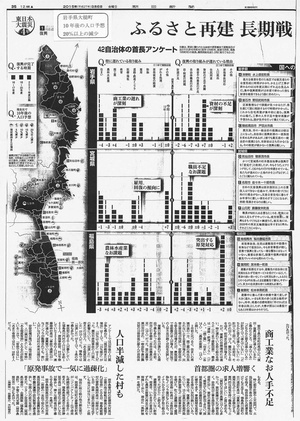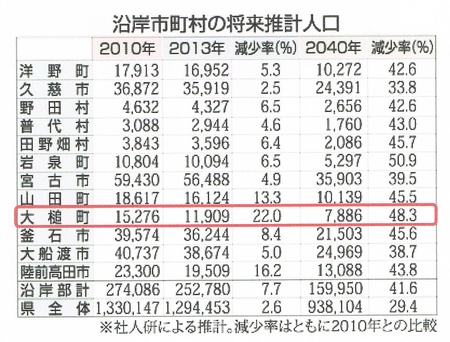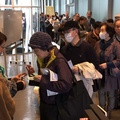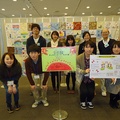March 11th marked the fourth year since the earthquake. It's slow progress, but the affected areas are steadily moving towards recovery. Land is being leveled for mass relocation sites. Public housing is being built for disaster victims. Shops and factories are being repaired and rebuilt. Railways are being restored. Businesses are being restarted. Though the pace differs, you can sense the city's revival in the ever-changing scenery of everyday life.
However, if we look closely at the progress, we see that it is not uniform across the country. There are areas affected by the nuclear plant and areas not affected. Inland and coastal areas. Urban areas and farming and fishing villages. Depending on how you approach it, the cross-section can look different.
Otsuchi Town, located on the coast of Iwate Prefecture, is a town centered on the fishing industry. It has a population of about 12,600 people (as of May 2014). 2,506 houses were washed away by the tsunami, and about 3,800 buildings were damaged by the earthquake and tsunami (as of September 28, 2011). This means that about half of the buildings in the town were damaged.
In response to these damages, the national, prefectural and municipal governments implemented unprecedented support measures, which are playing a vital role in rebuilding lives and reviving the local economy. For example, those who lost their homes in the tsunami will be given up to 6 million yen in support funds to build new homes.
| Total amount of support for housing reconstruction (new construction only) 1 | |||||
Household classification | Country (basic) | Country (additional fee) | Prefecture/town | Town specific* | total |
Multi-household | 1 million yen | 2 million yen | 1 million yen | 2 million yen | 6 million yen |
Single households | 750,000 yen | 1.5 million yen | 750,000 yen | 2 million yen | 5 million yen |
*Note: This applies only to households whose homes were completely or partially destroyed and demolished.
In addition, there are subsidy systems from the national and prefectural governments for businesses in the commercial, industrial, and fishing industries. The town has also drawn up a reconstruction plan to strongly support the recovery.
"The flute player did not dance." It may be said that this passage from the New Testament, "Matthew," describes the current state of revival.
In early February of this year, I received an email from my friend, Norm Ibuki, asking about the slow pace of reconstruction. In order to answer his question, I quickly researched the reasons and found that there are two main reasons. One is the labor shortage in the construction industry. The other is the soaring cost of construction .
Meanwhile, the Asahi Shimbun published the following article on March 6th of this year. It is the result of a survey of the heads of 42 cities, towns, and villages in the coastal areas hit by the tsunami and where evacuation orders have been issued due to the nuclear accident. The survey asked about 1) the delay in reconstruction, 2) the cause, 3) the timing of reconstruction, and 4) the predicted population in 10 years' time compared to the present.
In this survey, Otsuchi Town responded that it expects a population decline of more than 20% in the next 10 years. A figure of more than 20% is extremely high compared to other cities, towns, and villages .
For some time now, there has been a trend in Japan of population influx into urban areas and outflow from rural areas. Some point out that this phenomenon, which had been seen in Otsuchi Town for some time, has accelerated due to the Great East Japan Earthquake. In Otsuchi Town, there are many stories of young people and those raising children leaving the town after the disaster. As a result, it is the elderly who remain in the town.
Would they be able to borrow the large sums of money needed to build a house? Would they be able to repay the loan? With customers leaving town one after another, would they be able to restart their business and turn a profit? The more they think about it, the more depressed they become, and they can see images of people hesitant to take advantage of the support programs offered by the national and local governments.
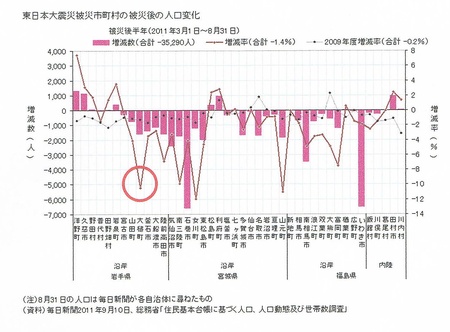
In the midst of all this, I learned of a family whose business accommodation and home had been swept away by the tsunami, and who were now living in temporary housing, hoping to restart their lives. I would like to share my conversation with the family’s third daughter, Izumi Higashitani5 , and send my heartfelt encouragement to this family as they go forward.
Q. What kind of damage did you suffer from the earthquake? Also, where was your family at the time, and what did they do afterwards?
My family consists of six people: my father, mother, two older sisters, my grandmother, and myself. The town of Ootsuchi in Iwate Prefecture where I lived was devastated by the earthquake and tsunami. Our house was close to the sea, so it was washed away by the tsunami.
At the time of the earthquake, I was a second-year high school student. I was busy with club activities at school when the earthquake occurred. My father is a member of the fire brigade. When the earthquake occurred, he immediately went to close the floodgates. He also assisted residents in evacuating. My mother and grandmother were at home. As a result, they were able to evacuate immediately after the earthquake. My eldest daughter was in Morioka (inland) for work. My second daughter, who also works in Morioka, suffered less damage. Thankfully, all of my family members were safe.
That day, each of my family members was affected by the disaster. I was only able to see my father, mother, and grandmother the next day. My two older sisters, who were in Morioka, were worried about us because they couldn't get through on the phone.
Q. What difficulties have you faced in terms of work or life as a result of the earthquake?
They stayed with relatives for about four months, and then moved to temporary housing. Not only their house but also their accommodation was washed away, so their father and mother, who ran a private lodging business, lost their jobs. Immediately after the disaster, they worked at the workplace of a relative who was looking after them, and also worked with debris removal. After moving to temporary housing, my parents continued to support the family by doing unfamiliar jobs.
Our relatives were very kind to us, but even though they were relatives, there were still some things we had to be careful about. So when we found out we could move into temporary housing, I remember feeling a bit relieved.
It has been almost three years since they moved into the temporary housing. They are concerned about the narrowness of the temporary housing, the warped floors, and the cold resistance. This is especially true for my grandmother, who is over 80 years old. She also seemed confused at first when interacting with people who had moved in from different areas. The temporary housing that she was grateful for when she first moved in is now becoming a place where she is suffering mentally and is becoming increasingly irritating.
Q. Are you currently living in temporary housing? If so, who is living there with you?
As mentioned above, we are living in temporary housing with my father, mother, and grandmother.
Q. If you have any plans for your future home or lifestyle, please tell us about them.
We plan to build a house and move out of the temporary housing. The land for this was decided in November last year. We are currently waiting for the land to be handed over, but this may take some time. The construction of the house will come after that.
Q. Living in Otsuchi, do you feel there are any inconveniences compared to before the earthquake? If so, what are they?
I lived in Otsuchi until my third year of high school, but now I live in Sendai (the economic center of the Tohoku region).
The inconveniences we felt then and now when we return to our hometown are that we live in temporary housing, far from the city. This makes it difficult to meet friends. Also, transportation is not convenient, so when my grandmother goes to the hospital, we have to rely on taxis or my parents to take her to and from work. Also, the temporary housing itself feels cramped for us, who lived in a single-family home before the disaster.
Q. People have pointed out that the town's reconstruction is lagging behind. What do you think is the reason for this?
I think the cause lies in the town as a whole. Otsuchi's population was already declining before the disaster, and after the disaster, the number of people leaving the town increased even more. Young people are also leaving Otsuchi. The population outflow problem, which existed before the disaster, has come under scrutiny again since the disaster.
Otsuchi has a lot of elderly people and few young people in their prime. When I went back to my hometown the other day, I saw an article about the shortage of childcare workers at daycare centers. If this situation continues, they may refuse to accept infants and young children. I think it's a terrible situation where the work environment is difficult and the number of people is decreasing.
Reconstruction requires manpower. Isn't this a problem that the entire town needs to think about? Rather than simply criticizing the delay in reconstruction, I think residents should seriously consider the issue as people involved. I fear that if the entire town does not make changes, the town will continue to decline rather than recover.
Notes:
1. Regarding housing reconstruction, materials from the Otsuchi Town Reconstruction Bureau were used.
Ootsuchi Town's unique support project [Subsidy project for disaster victim support]
(Otsuchi Town Reconstruction Bureau, August 2013)
2. Otsuchi Town Great East Japan Earthquake and Tsunami Reconstruction Plan and Implementation Plan [Second Phase: Reconstruction Period, FY2014 to FY2016]
(Otsuchi Town, Iwate Prefecture, March 2014)
3. Current affairs and public opinion : "Delayed reconstruction of homes, prolonged life in temporary housing"
(NHK Commentary Committee, July 24, 2014)
4. Regarding population decline, data was taken from the online edition of the Iwate Nippo newspaper.
"The Continuing Population Decline (Part 1): It is unclear whether the population will recover" (January 7, 2014)
5. Izumi Higashitani will be a fourth-year university student starting this April.
© 2015 Tsutomu Nambu


